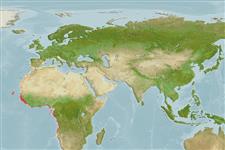Classification / Names
Common names from other countries
Main reference
Size / Weight / Age
Max length : 100.0 cm TL male/unsexed; (Ref. 2683); 98.0 cm FL (female); common length : 75.0 cm TL male/unsexed; (Ref. 2683); max. published weight: 6.0 kg (Ref. 40637); max. reported age: 5 years (Ref. 27160)
Length at first maturity
Lm 37.3, range 33 - 45 cm
Environment
Marine; brackish; pelagic-neritic; oceanodromous (Ref. 51243); depth range 1 - 40 m (Ref. 28173), usually 20 - 25 m (Ref. 28173)
Climate / Range
Tropical, preferred 24°C (Ref. 107945); 45°N - 19°S, 24°W - 14°E (Ref. 168)
Distribution
Eastern Atlantic: Canary Islands and Senegal to the Gulf of Guinea and Baía dos Tigres, Angola. Rarely found in the northern Mediterranean Sea, along the coasts of France and Italy. This species has been erroneously been considered as a synonym of Scomberomorus maculatus by many authors.
Countries | FAO areas | Ecosystems | Occurrences | Introductions
Short description
Dorsal
spines
(total): 15 - 18;
Dorsal
soft rays
(total): 0;
Anal
soft rays: 17 - 20;
Vertebrae: 46 - 47. Interpelvic process small and bifid. Body covered with small scales. Lateral line gradually curving down toward caudal peduncle. Intestine with 2 folds and 3 limbs. Swim bladder absent. Some large individuals with thin vertical bars. Anterior half of first dorsal fin and margin of posterior half of first fin black.
IUCN Red List Status (Ref. 115185)
Threat to humans
Harmless
Human uses
Fisheries: commercial
More information
ReferencesAquacultureAquaculture profileStrainsGeneticsAllele frequenciesHeritabilityDiseasesProcessingMass conversion
Tools
Special reports
Download XML
Internet sources
Estimates of some properties based on models
Phylogenetic diversity index
PD50 = 0.5000 many relatives (e.g. carps) 0.5 - 2.0 few relatives (e.g. lungfishes)
Trophic Level
4.3 ±0.74 se; Based on food items.
Resilience
Medium, minimum population doubling time 1.4 - 4.4 years (K=0.31-0.33; tmax=5; Fec=1 million)
Vulnerability
Moderate vulnerability (38 of 100)
Price category
